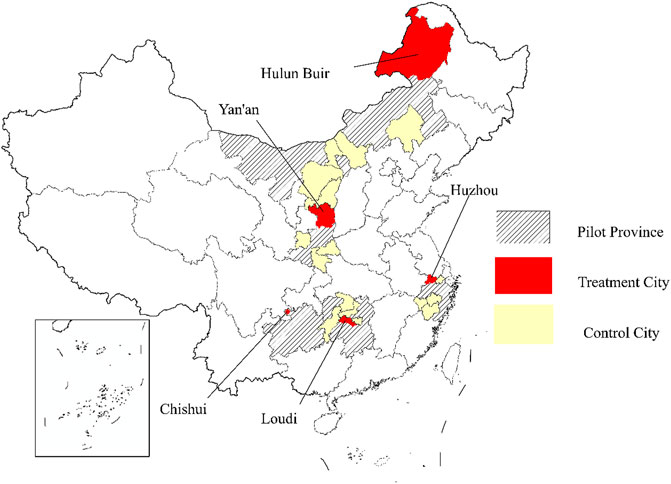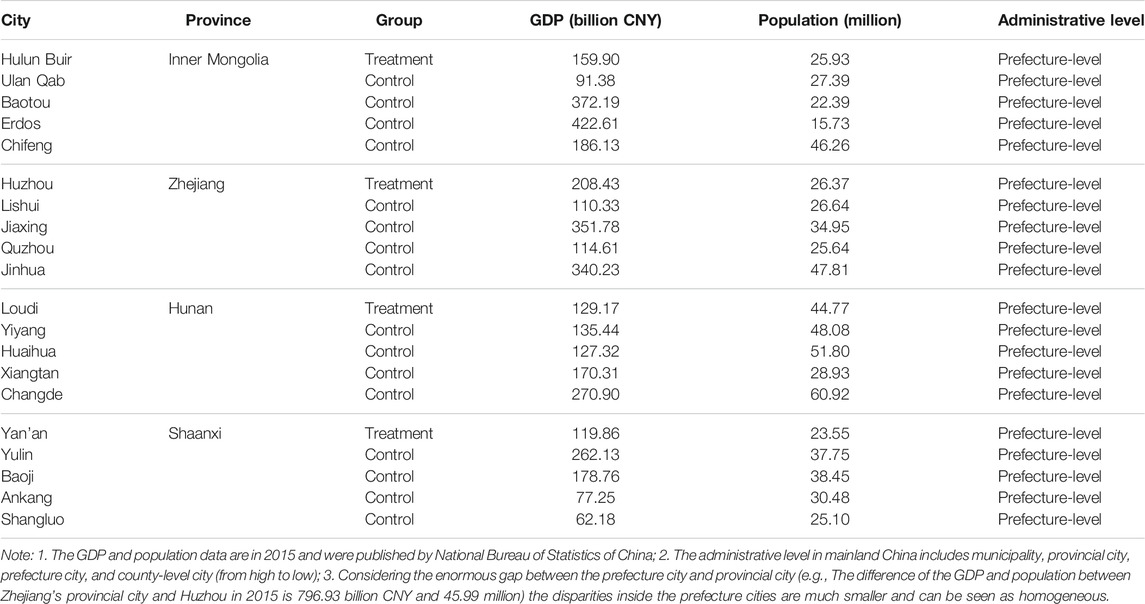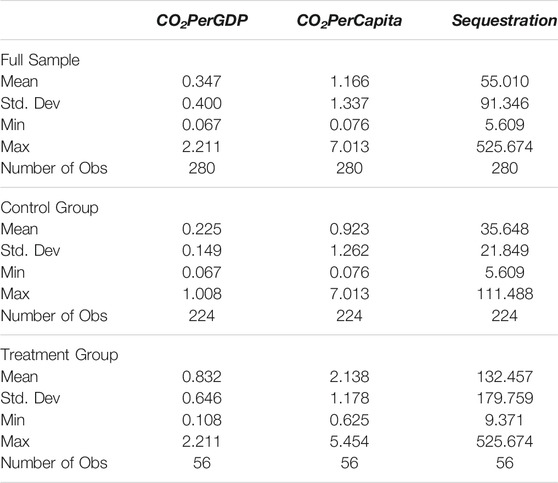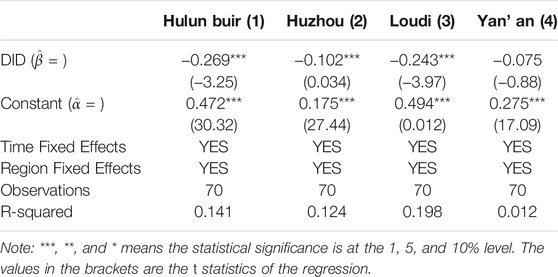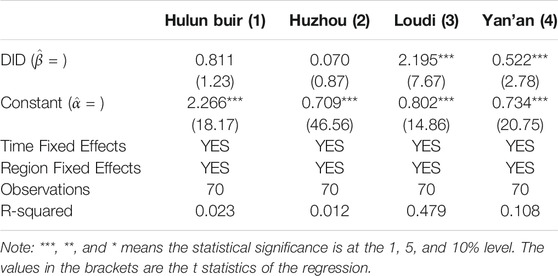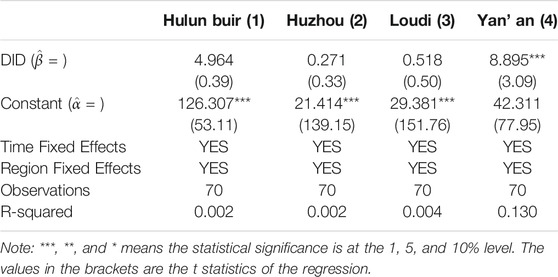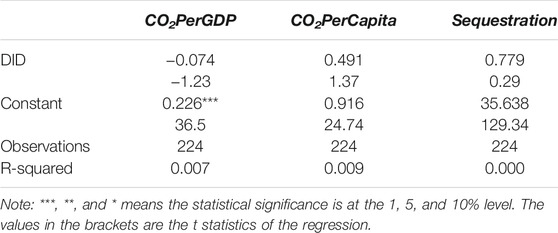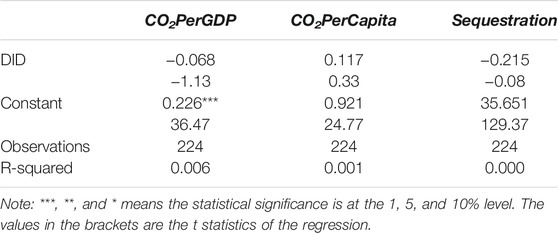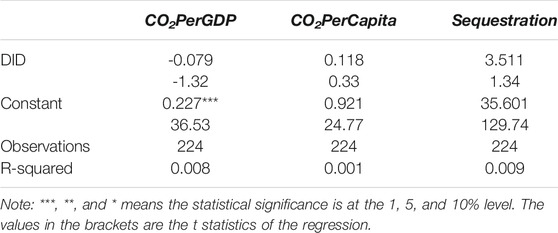- 1School of Economics, Hainan Open Economy Research Institute, Hainan University, Haikou, China
- 2International Centre for Transformational Entrepreneurship and Center for Business in Society, Coventry University, Coventry, United Kingdom
- 3Surrey Business School, University of Surrey, Guildford, United Kingdom
- 4School of Business Administration, Zhongnan University of Economics and Law, Wuhan, China
- 5Research Center for Environment and Health, Zhongnan University of Economics and Law, Wuhan, China
There has been renewed interest in assessing the pilot scheme for compiling the natural resources capitalization (NRC). A growing body of evidence highlights the good effects that the policy of NRC has on the construction of ecological civilization. No known empirical research has focused on exploring relationships between the policy of NRC and carbon emissions reduction. This paper employs the NRC as the ecological civilization policy to investigate whether the implementation of NRC has contributed to the carbon emissions reduction with a difference-in-differences (DID) method. The results showed that different variables of carbon emissions in four pilot cities can be effectively affected by the implementation of NRC. There were significant negative correlations between the carbon emissions per GDP (Gross Domestic Product) and the policy for Hulun Buir, Huzhou and Loudi cities, and a significant increase of carbon sequestration was found in Yan’an city. This research provides a timely and necessary study that the NRC policy could be a contributing factor to carbon emissions reduction. As a result of these investigations, suggestions were identified for future research. Further research should be undertaken to investigate the collaborative effects of multi-policies on environmental issues.
Introduction
Global climate change has become one of the biggest challenges to human development and poses a major threat to human society, which has attracted considerable attention, both scholarly and socially (Thomas et al., 2004; Davidson and Janssens, 2006; Meng et al., 2018). According to the report of the Intergovernmental Panel on Climate Change (IPCC) in October 2018, the world must control global warming within 1.5°C to avoid extreme climate disasters (IPCC, 2018). Only when the whole world achieves net-zero emission of greenhouse gases in the middle of the 21st century, can this goal be achieved (Yao et al., 2021). At present, more than 120 countries and regions around the world have put forward the goal of carbon neutrality. And among which, 60 countries have promised to achieve zero carbon emissions by 2050 or even earlier based on the report of the Secretariat of the United Nations Framework Convention on Climate Change (UNFCCC) in 2019 (UNFCCC, 2019). China is the largest total carbon emitter in 2020 currently, accounting for 32% of the world (IEA, 2020). With China’s rising carbon emissions in the world, both the carbon emission reduction pressure and responsibility are greater (Onyango et al., 2019). In 2015, China submitted its National Subsidy Contribution (NDC), promising to reduce CO2 emissions per unit GDP by 60–65% compared with 2005 by 2030, and formally signed the Paris Agreement in 2016 (UNFCCC, 2016). At the general debate of the 75th session of the United Nations General Assembly on 22 September 2020, China made it clear that its carbon dioxide emissions will reach the peak before 2030 and strive to achieve carbon neutrality before 2060 (UN, 2020). On 18 December 2020, at the Central Economic Work Conference, carbon neutrality was listed as one of the eight key tasks of the country in 2021.
The issue of carbon neutrality, an important concept in the study of climate change, has received considerable critical attention (Zanchi et al., 2012; Ji et al., 2014). It is a systematic process that requires the cooperation of multiple departments to achieve this goal (Yue et al., 2021; Zhang et al., 2021). Recent research has reported that setting emission reduction targets is substantially delineating the boundaries of natural capital (or carbon assets) (Zhou et al., 2021). China’s “14th Five-Year Plan”, starting from 2021, allocates the national emission reduction target to various provinces and cities, where key carbon emission enterprises are deeply involved. A number of policies in China have been developed to achieve the peak carbon dioxide emissions and carbon neutralization (Wen et al., 2020; Soregaroli et al., 2021). One of the most important policies was capitalization of natural resources (NRC) (Fan et al., 2020). However, what remains unknown is how such policy and practice affect the carbon emissions. From an economic perspective, this is a process of defining property rights. The capitalization of natural resources is the basis for the definition of natural capital property rights. Therefore, in theory, the preparation of the capitalization of natural resources (NRC) is beneficial to the realization of carbon neutrality, but no known empirical research has focused on exploring relationships between pilot schemes for compiling capitalization of natural resources and carbon emissions.
In 2015, the General Office of the State Council issued the pilot scheme for compiling capitalization of natural resources, clearly pointed out that the pilot work should be carried out in Hulun Buir City of Inner Mongolia, Huzhou City of Zhejiang Province, Loudi City of Hunan Province, Chishui City of Guizhou Province and Yan’an City of Shaanxi Province (MNR, 2015). Natural resources capitalization is fundamental to promoting the effective use of natural resources and the construction of ecological civilization in China (Zhang et al., 2019b; Song et al., 2020a). There has been extensive research on the accounting of water resources, forest resources, land resources and other natural resources assets (Zhang et al., 2019a; Zhu et al., 2021). For example, the mining of mineral resources plays a key role in carbon emissions growth (Wang et al., 2017), and the capitalization of land resources has brought favorable changes in environmental loads, ecosystem services and growth models in several districts and counties (Fan et al., 2020; Fan et al., 2021). Recent research suggests that there is a positive relationship between natural resources management policy and environmental quality (Kurniawan et al., 2021). Therefore, questions have been raised about whether the NRC can achieve a win-win situation of eco-environmental protection and low-carbon emission reduction. The year 2015 can be regarded as the time point for the implementation of the scheme in China, which is a top-down process and lays a foundation for considering NRC as a “quasi-natural experiment”, enabling us to apply a difference-in-differences (DID) identification strategy. This study will combine panel data to compare the changes in low-carbon emission reduction in pilot cities before and after the implementation of NRC. Further description of this method will be introduced in Section 2.2.
What we know about carbon neutrality is derived from research by Schlamadinger, which explores whether it is true carbon neutral in the whole life cycle when biomass energy replaces fossil fuels (Marland and Schlamadinger, 1997). Recently, considerable literature has grown up around the theme of carbon emissions. A key aspect of this field is CO2 emission reduction technologies, including CO2 capture and storage (CCS) (Xu et al., 2021), carbon sink (Pan et al., 2011), biochar (Papageorgiou et al., 2021; Wang et al., 2021) and carbon sequestration (Marland and Schlamadinger, 1997; Lal, 2004; Laudicina et al., 2021). There has also been a surge of interest in the effects of these numerous techniques (Bonan, 2008; Fuhrman et al., 2020). What’s more, existing research recognizes the critical role played by the market that includes carbon tax (Soregaroli et al., 2021; Zhang et al., 2021) and carbon emissions trading scheme (Wang et al., 2019). Recent evidence suggests that there is a positive relationship between China’s carbon emissions trading scheme (ETS) and companies’ stock returns (Wen et al., 2020). Also, it has been observed that ETS could be a contributing factor to energy conservation and emission reduction (Zhou et al., 2019; Sun et al., 2020). To date, factors found to be influencing carbon emissions have been explored in several studies (Gao et al., 2020; Nie et al., 2020; Yi et al., 2020; Hao et al., 2021; Ling et al., 2021). An investigation regarding the Yangtze River Delta has examined that industrial transformation gradually dominated by the service and advanced manufacturing sectors are thought to contribute to slow growth in CO2 emissions (Zhang S. et al., 2019). One study by Yang and Wang (2020) examined the effect of population aging on carbon emissions, and found that population aging has a negative coefficient on carbon emissions. In a study conducted by Lin and Zhu (2019), it was shown that renewable energy technological innovation (RETI) had a significant effect on CO2 emissions. Hong et al. (2021) found that the low-carbon city pilot policy can effectively reduce the energy intensity. Emissions in cities were shown to vary in response to different local public expenditure, local public expenditure scale and public environmental expenditure (Cheng et al., 2021). Although there are several reports in the literature on carbon emissions and related factors over the past decade, few studies have been able to consider the important role played by NRC. This study provides a timely and necessary study of this policy and its effect on carbon emissions.
Theoretically, the impact of NRC on carbon emissions may exist in three different aspects. First of all, according to the Porter Hypothesis, environmental policies and regulations could stimulate technological innovation (Hu et al., 2020; Du et al., 2021). Specifically, the compliance pressure of NRC could motivate the pilot cities to increase investment in innovation and to improve technological progress, which may propel the improvement of the efficiency of resource and energy use with less greenhouse gas emission or more advanced carbon capture and storage technologies. Also, NRC could encourage key firms to improve the allocation of input factors, protect resources, and then promote eco-environmental protection and low-carbon production (Yang et al., 2017; Song et al., 2020b). For example, when natural resources such as forests have been priced, the exploitation cost for the enterprises will rise accordingly, this can relieve the depletion of natural wealth and urge the enterprises to promote their green productivities based on existing resources (Ogilvy, 2015; Sokil, 2018). These measures can indirectly affect the energy structure and industrial structure and finally achieve emission reduction targets. What’s more, a key measure of NRC policy is compiling the natural resources balance sheet (NRBS) to intake the resources like land, forest and water into national assets, requiring the local to preserve them from devaluation and to make their value increase as far as possible, this may enable the expansion of the green plants and the carbon sequestration will increase since then (Song et al., 2019). As a consequence, the role played by NRC on climatic effects, with its influencing mechanism, is worth detecting.
On the basis of a batch of NRC pilot Chinese cities selected in 2015, the primary aim of this paper is to explore the relationship between NRC and carbon emissions, and a further interpretation of heterogeneous results will be discussed if the pilot cities showed differential results. In the pages that follow, the remaining issues will be addressed. Section 2 introduces the study area, data, and the economic model employed for this study. The third part seeks to analyze the data gathered and addresses each of the research questions in turn. And the fourth section of this paper is concerned with discussion undertaken upon the various theoretical and empirical strands of the thesis. The final part draws together the key findings, making the implication of the findings to future research.
Data and Method
Study Area and Data
Data were gathered from multiple sources, including annual China City Statistical Yearbooks (CCSY) from 2004 to 2017, China Environmental Statistics Database (CESD) and published literature. The CCSY are informative publications published by the National Bureau of Statistics of the People’s Republic of China, which comprehensively reflects the economic and social development of Chinese cities. There has been substantial research undertaken with the support of data from CCSY (Wang et al., 2019; Song et al., 2020b). The county-level CO2 emissions and sequestration data in China during 2004–2017 were open data offered by Chen et al. (2020). It has been filled for partial missing data through forward and backward interpolation.
Balancing the growing demand and climate change is a key motivating factor for enacting the NRC in China, where the corresponding measurement index can be embodied with the following variables: CO2 emission per unit GDP, CO2 emission per capita and carbon sequestration amount. In summary, Figure 1 provides a possible mechanism of action for NRC in the climatic environment.
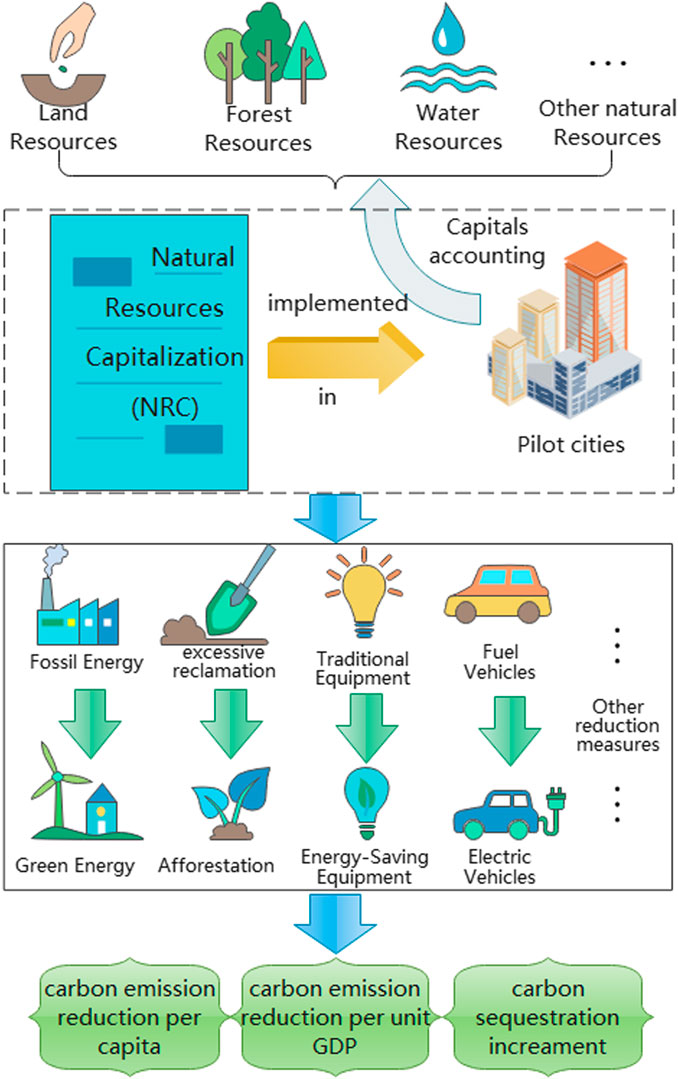
FIGURE 1. Flowchart of NRC implementation analysis1.
The key point of NRC is the capitalization of natural resources including land, forest, water, etc. As Figure 1 shows, the NRC policy requires the pilot cities to conduct the natural capitals accounting and to charge for the exploitation of the natural resources. This obligates the pilot cities to develop more elaborate and rational industrial and civilian use of natural resources, including transiting fossil energy to cleaner energy, afforesting marginal farmland, popularizing energy-saving equipment in buildings, and subsidizing electric vehicles. During this resource-protecting and energy-saving process, three positive results may come into being: CO2 reduction per capita, CO2 reduction per unit GDP, and promotion of carbon sequestration.
Some basic city-relevant information was obtained from the CCSY. Of our interest, we get the data of GDP and population. And the CESD provides carbon emissions of different cities. In particular, the treatment group analyzed in this study contains pilot regions except for Chishui as it is a county rather than a city of others. Thus, the implementation of the NRC policy on carbon emissions could be shown in Figure 2.
With respect to the control group, a number of criteria were considered when selecting the control cities as follows. First, those cities included in the control group should not be under the pilot scheme of NRC. Then, the cities in both the treatment group and control group should have homogeneous features that affect carbon emissions other than NRC. That is to say, the pilot and control cities should have similar GDP, amount of population, level of administration (rather than provincial cities), and surroundings or even the climate. This study will choose four representative control cities for each pilot city with the comprehensive consideration of homogeneity on the geographical position and city scale. What’s more, to rule out the possibility of geographical difference, the cities out of the pilot province were not selected. Taken together, 16 representative control cities which matched the selection criteria were identified, and the detailed information of treatment and control groups is shown in Table 1.
Economic Model Specifications
Several methods currently exist for the assessment of environmental policy and action (Cheng et al., 2021; Lu et al., 2021; Wang and Qiu, 2021; Yang et al., 2021). Among which DID is one of the most widely-used tools, as the usefulness of this technique has been demonstrated in several notable research. Samples were analyzed using DID that was detailed for effects of medical marijuana and recreational marijuana use (Pacula et al., 2015). Li et al. (2016) found that the flattening of the government hierarchy has a negative effect on economic performance with the Propensity Score Matching and DID (PSM-DID). Wen et al. (2020) argue that companies participating in the carbon market have higher carbon exposures when the conditions of the coefficient of carbon risk factor, a parameter of the DID model, is significantly positive. In recent years, DID is frequently utilized for the evaluation of environmental policy and action (Agüero and Beleche, 2014; Agüero and Beleche, 2017; He et al., 2020; Yang et al., 2020; Ye et al., 2020; Zhou et al., 2020). Therefore, the relationship between NRC and carbon emissions for this study was examined using DID. Data management and analysis were performed using Stata 16.0. Descriptive data were generated for all variables. Statistical significance levels were analyzed using analysis of variance and t-tests.
As Table 2 shows, five variables are used to investigate the effect of the Natural Resource Balance Sheet (NRC), where the explained variables are the Carbon emission per unit of GDP, per capita, and the total carbon sequestration of the pilot cities. The pilot policy of NRC, indicated as DID, represents the key dummy variable whose significance we want to verify. Besides, two controlled variables, the output value of primary industry and retail sales are listed as they may affect the three explained variables under the conditions that they are not the pilot duties of NRC.
To verify the pilot scheme of NRC, Difference-In-Differences (DID) models are set as follows:
From the above, (1) (2) are the main DID models aimed at finding whether NRC policy can effectively lower the carbon emissions in terms of unit gross regional production (CO2PerGDP) and per capita (CO2PerCapita). (3) is a DID model to verify whether NRC can promote carbon sequestration (Sequestration), which is fixing the carbon dioxide from blowing into the atmosphere. i denotes the individual (city) and t represents the time (year). The second factor in (Eqs 1–3),
Empirical Results
Descriptive Statistics
The sample data for pilot and non-pilot cities in this research are obtained from annual CCSY and CESD from 2004 to 2017.4 non-pilot cities are being treated as control groups for each pilot region, considering the complex nature of geographical factors. The number of observations for the control group is 4 times over than the treatment group. Simple statistical analyses of all variables, including CO2 emissions per GDP, CO2 per Capita and carbon sequestration, are set out in Table 3. Of all samples, we can see that the mean values of all variables in the treatment group were much higher than those in the control group. For instance, the mean of CO2PerGDP in the treatment group is about four times more than that in the control group; the mean of CO2PerCapita is over two times more than that in the control group; the mean of Sequestration is about four times as that in the control group.
Regression Results
The results obtained from the regression analysis of NRC pilot policy in 2015 on carbon emissions are presented in Tables 4–6. Table 4 provides the overview of carbon emissions in terms of unit gross regional production in four treated cities. Columns (1) to (4) show the outcome of Hulun Buir, Huzhou, Loudi and Yan’ an, respectively, which is the same as Table 5; Table 6. Apparently, there was a significant negative correlation between the pilot cities and CO2PerGDP at the p = 0.01 level, except for Yan’an city. The difference in carbon emissions in terms of unit gross regional production between the treatment and control groups in Hulun Buir, Huzhou, and Loudi were significant. The results indicated that, following each thousand increase in GDP, the CO2 emissions decreases 0.269, 0.102, and 0.243 ton for these three pilot cities after NRC implementation than the control group. While no statistically significant correlation was observed between balanced control and treatment groups in Yan’ an city.
The regression results of CO2PerCapita are displayed in Table 4. It is obvious that a significant difference was found between the NRC policy and carbon emissions in terms of per capita in Loudi and Yan’an cities. The values of CO2PerCapita in these two cities were distinctly higher than those in the control groups at the p = 0.01 level. Also, the coefficient estimates of DID for Hulun Buir and Huzhou cities reported in the table showed that there was no significant difference in both groups after the policy implementation.
The regression results of sequestration can be seen in Table 6. Of four pilot cities, surprisingly, only one coefficient evaluation of DID shows a significant increase of sequestration, suggesting that NRC policy in Yan’ an city has brought significant improvement in carbon reduction at a 1% significant level. No significant increase in carbon sequestration was detected in Hulun Buir, Huzhou and Loudi cities, which means sequestration of these regions tends to be insignificantly affected by NRC policy.
Parallel Trend Analysis
This study took the form of “parallel trend analysis” to identify the premise condition of DID estimation. Specifically, it needs to be ensured that treatment and control groups have similar development trends without policy interference. Figure 3 shows the change trends of the mean values for the variables including CO2PerGDP and Sequestration of the pilot and non-pilot cities. An inspection of the results in the figure reveals that they basically follow similar patterns before the implementation of pilot policy, although the results show a slight difference.
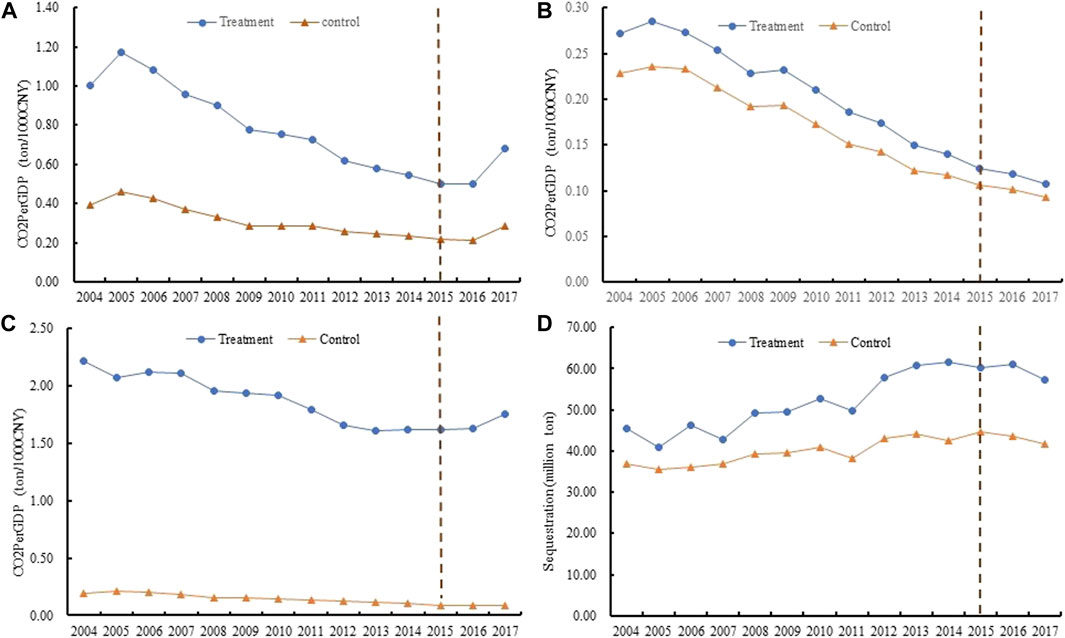
FIGURE 3. Trends of average values of explained variables of the pilot and non-pilot cities over 2004–2017. Note: (A), (B), and (C) are the results of CO2PerGDP for Hulun Buir, Huzhou and Loudi cities, respectively. (D) displays the trend of Sequestration for Yan’an city.
Robustness Checks
According to the analysis above, there were significant correlations between the implementation of NRC policy and different explained variables (CO2PerGDP, CO2PerCapita and Sequestration), which contributes to the reduction of carbon emissions to a certain degree. The correlation between the implementation of the NRC policy and the reduction of carbon emissions was verified using robustness checks. This study selected four randomized controlled cities as the assumed pilot cities to conduct the counterfactual tests. Hence, it could conceivably be hypothesized that these assumptive cities were implemented the NRC policy in 2015. If statistically significant results were still observed between explained variables and the policy of NRC, we can infer that the reduction of carbon emissions may be caused by other unobserved factors rather than NRC. The regression results from four cities of three explained variables are displayed in Tables 7−10.
Looking at Tables 7–10, it can be seen that no statistically significant correlation between the three explained variables for all four assumptive cities and the policy of NRC, which means NRC is the unique exogenous impact for the true pilot cities. Therefore, the counterfactual results validate the reliability of the empirical results in 3.2. On average, the policy of NRC was shown to have a positive effect on carbon emissions reduction from different indicators in this study. We can then conclude that the implementation of NRC makes the relevant pilot cities paid more attention to environmental protection, and utilization efficiency of natural resources, which contributed to the achievement of carbon neutrality.
Discussion
The empirical results above have proven that the NRC policy can exert positive effects on the carbon emission reduction accompanied by economic growth. Three of four pilot cities in China achieved the reversion of high-carbon growth as NRC brought down the CO2 emissions per unit of GDP, indicating that the public awareness of low-carbon development can be aroused by treating natural resources like social assets. Despite the carbon drop effect on the unit economy has not been significant in the fourth city, Yan’an, the effect on carbon sequestration is fairly fruitful in this pilot city, as its statistically significant coefficient on carbon sink is much larger. Table 10 summarizes the distribution of the results on four pilot cities.
As Table 11 displays, in each pilot city, NRC can only bring in one of three positive effects, this indicating a single environmental protection policy can only achieve limited mitigation, or even give rise to non-ideal effects such as per-capita carbon emission’s increasing in Loudi and Yan’an cities.
The differentiated results among the four pilot cities may be due to their heterogeneous regional characteristics (Yu and Tsai, 2018; Tang and Dou, 2021). Compared with the other three cities, Yan’an has the lowest scale of the secondary industry, with only 18.0, 10.8 and 17.7% of the secondary industry’s output value in Hunlun Buir, Huzhou and Loudi averagely from 2015 to 2017, this weakened its emission-reducing potential because the manufacturing industry is the main source of CO2 emission.
As for the CO2 emission per capita, economic activities may explain the negative effect on Loudi and Yan’an, the residents’ retail spending in Loudi and Yan’an is 58.81 million and 81.24 million less than Huzhou’s in the post NRC period averagely, indicating that the basic household needs occupied more family spending where energy-intensive products such as heating and refrigeration are essential (Liu et al., 2021).
Although Yan’an has not benefited from the first two effects, carbon sequestration has only been promoted significantly there after the execution of NRC. A reliable reason is that the barren soil in northwest China enables larger development space on the contrary, where Yan’an is a part of the large-scale tree planting action in northwest China guided by the Central government. The new forestation area reached 13.64 million-acre in 2018 compared to 2004, including the 7.18 million acres of farmland’s returning (Zhang et al., 2018), and NRC could strengthen this process. Hence, more carbon sequestration could be created considering the larger land space in northwest regions.
Considering the distinguishing results above, a synergism of multiple green environment policies is necessary for realizing greater abatement. Fortunately, more countermeasures have come into effect since 2018, such as ultra-low emission of iron and steel industry, or building of energy storage facilities to serve the growing renewable energy. Further research should be undertaken to investigate the collaborative effects of multi-policies on environmental issues.
Conclusion and Policy Recommendations
This study has examined the relationship between the implementation of NRC and carbon emissions reduction. The following conclusions can be drawn from the present investigation. First, the findings clearly indicated, following the increase in each increase of one thousand GDP, that the impact on CO2 emissions was statistically significant negative, about almost 0.269, 0.102, and 0.243 decreases in three pilot cities, which are Hulun Buir, Huzhou and Loudi, respectively. Second, the results of this study showed that there was a significant positive correlation between the policy of NRC and Sequestration in Yan’an City, although the indicator CO2PerGDP of that region appeared to be unaffected by this scheme. The evidence from these findings indicates that carbon emission reduction can be partially achieved through the implementation of NRC. All the results were tested successfully by robustness tests. Taken together, this study appears to provide the first comprehensive assessment of NRC on carbon emission reduction. These results have significant implications for the understanding of how NRC affects carbon emissions, which complement those of earlier studies.
In line with the findings, this study has a number of policy implications for future practice. On the one hand, carbon emission is considered not only a climate issue, but also an environmental factor. The policy of NRC has demonstrated to achieve a win-win situation between the construction of ecological civilization and climate mitigation. Therefore, it is an efficient way for the government to encourage enterprises to promote their green productivities based on existing resources, since the natural resources such as forests have been priced, the exploitation cost for the enterprises will rise accordingly. On the other hand, this information can be used to develop targeted inventions aimed at carbon emissions reduction with many other green environmental policies. The results have confirmed the important role played by NRC on carbon emissions reduction, although the effect of NRC is different in various pilot cities. Cities with higher natural resources should do their best to intake them into national assets, add their value as far as possible, and eventually expand the coverage scale of green plants and increase the carbon sequestration.
Despite these promising results, some limitations need to be noted regarding the present study. First, this analysis has only examined the role of NRC on carbon emissions reduction without considering the context of many other green environmental policies. Also, with relatively small samples, caution must be applied regarding the generalizability of these findings. Further studies, which take other variables into account, will need to be undertaken to develop a deeper understanding of the relationships between the collaborative effects of multi-policies on environmental issues and carbon emissions.
Data Availability Statement
The original contributions presented in the study are included in the article/supplementary material, further inquiries can be directed to the corresponding author.
Author Contributions
PY: Conceptualization, Methodology, Data curation, Formal analysis, writing-original draft, Project administration. SX: Conceptualization, Writing-review and editing. YX: Conceptualization, Supervision, Writing-review and editing. YL: Methodology, Formal analysis, Writing-original draft, Funding acquisition,. LC: Methodology, Writing-review and editing.
Funding
This work is supported by the China Scholarship Council (CSC 202107080008).
Conflict of Interest
The authors declare that the research was conducted in the absence of any commercial or financial relationships that could be construed as a potential conflict of interest.
Publisher’s Note
All claims expressed in this article are solely those of the authors and do not necessarily represent those of their affiliated organizations, or those of the publisher, the editors and the reviewers. Any product that may be evaluated in this article, or claim that may be made by its manufacturer, is not guaranteed or endorsed by the publisher.
Footnotes
1The image elements are provided by Edrawsoft.cn, where the authors have purchased the use right through software licensing.
References
Agüero, J. M., and Beleche, T. (2017). Health Shocks and Their Long-Lasting Impact on Health Behaviors: Evidence from the 2009 H1N1 Pandemic in Mexico. J. Health Econ. 54, 40–55.
Chen, J., Gao, M., Cheng, S., Hou, W., Song, M., Liu, X., et al. (2020). County-level CO2 Emissions and Sequestration in China during 1997-2017. Sci. Data 7 (1), 391. doi:10.1038/s41597-020-00736-3
Cheng, S., Chen, Y., Meng, F., Chen, J., Liu, G., and Song, M. (2021). Impacts of Local Public Expenditure on CO2 Emissions in Chinese Cities: A Spatial Cluster Decomposition Analysis. Resour. Conservation Recycling 164. doi:10.1016/j.resconrec.2020.105217
Davidson, E. A., and Janssens, I. A. (2006). Temperature Sensitivity of Soil Carbon Decomposition and Feedbacks to Climate Change. Nature 440 (7081), 165–173. doi:10.1038/nature04514
Du, K. R., Cheng, Y. Y., and Yao, X. (2021). Environmental Regulation, green Technology Innovation, and Industrial Structure Upgrading: The Road to the green Transformation of Chinese Cities. Energ. Econ. 98, 10. doi:10.1016/j.eneco.2021.105247
Fan, W., Chen, N., Li, X., Wei, H., and Wang, X. (2020). Empirical Research on the Process of Land Resource-Asset-Capitalization-A Case Study of Yanba, Jiangjin District, Chongqing. Sustainability 12 (3), 1236. doi:10.3390/su12031236
Fan, W., Chen, N., Yao, W., Meng, M., and Wang, X. (2021). Integrating Environmental Impact and Ecosystem Services in the Process of Land Resource Capitalization-A Case Study of Land Transfer in Fuping, Hebei. Sustainability 13 (5), 2837. doi:10.3390/su13052837
Fuhrman, J., McJeon, H., Patel, P., Doney, S. C., Shobe, W. M., and Clarens, A. F., (2020). Food-energy-water Implications of Negative Emissions Technologies in a +1.5 °C Future. Nat. Clim. Chang. 10(10), 920, 927-+.doi:10.1038/s41558-020-0876-z
Gao, Y., Li, M., Xue, J., and Liu, Y. (2020). Evaluation of Effectiveness of China's Carbon Emissions Trading Scheme in Carbon Mitigation. Energ. Econ. 90. doi:10.1016/j.eneco.2020.104872
Greenstone, M., and Hanna, R. (2014). Environmental Regulations, Air and Water Pollution, and Infant Mortality in India. Am. Econ. Rev. 104, 3038–3072. doi:10.1257/aer.104.10.3038
Hao, L. N., Umar, M., Khan, Z., and Ali, W. (2021). Green Growth and Low Carbon Emission in G7 Countries: How Critical the Network of Environmental Taxes, Renewable Energy and Human Capital Is. Sci. Total Environ. 752, 141853. doi:10.1016/j.scitotenv.2020.141853
He, G., Xie, Y., and Zhang, B. (2020). Expressways, GDP, and the Environment: The Case of China. J. Dev. Econ. 145, 102485. doi:10.1016/j.jdeveco.2020.102485
Hong, M., Chen, S., and Zhang, K. (2021). Impact of the “Low-Carbon City Pilot” Policy on Energy Intensity Based on the Empirical Evidence of Chinese Cities. Front. Environ. Sci. 9. doi:10.3389/fenvs.2021.717737
Hu, Y., Ren, S., Wang, Y., and Chen, X. (2020). Can Carbon Emission Trading Scheme Achieve Energy Conservation and Emission Reduction? Evidence from the Industrial Sector in China. Energ. Econ. 85. doi:10.1016/j.eneco.2019.104590
IPCC (2018). Mitigation Pathways Compatible with 1.5 °C in the Context of Sustainable Development. Available at: https://www.ipcc.ch/sr15/chapter/chapter-2/.
Ji, H., Zhao, X., Qiao, Z., Jung, J., Zhu, Y., Lu, Y., et al. (2014). Capacitance of Carbon-Based Electrical Double-Layer Capacitors. Nat. Commun. 5, 3317. doi:10.1038/ncomms4317
Kurniawan, R., Sugiawan, Y., and Managi, S. (2021). Economic Growth - Environment Nexus: An Analysis Based on Natural Capital Component of Inclusive Wealth. Ecol. Indic. 120, 10. doi:10.1016/j.ecolind.2020.106982
Lal, R. (2004). Soil Carbon Sequestration Impacts on Global Climate Change and Food Security. Science 304 (5677), 1623–1627. doi:10.1126/science.1097396
Laudicina, V. A., Dazzi, C., Delgado, A., Barros, H., and Scalenghe, R. (2021). Relief and Calcium from gypsum as Key Factors for Net Inorganic Carbon Accumulation in Soils of a Semiarid Mediterranean Environment. Geoderma 398, 10. doi:10.1016/j.geoderma.2021.115115
Li, P., Lu, Y., and Wang, J. (2016). Does Flattening Government Improve Economic Performance? Evidence from China. J. Dev. Econ. 123, 18–37. doi:10.1016/j.jdeveco.2016.07.002
Lin, B., and Zhu, J. (2019). The Role of Renewable Energy Technological Innovation on Climate Change: Empirical Evidence from China. Sci. Total Environ. 659, 1505–1512. doi:10.1016/j.scitotenv.2018.12.449
Ling, Y. T., Xia, S. M., Cao, M. Q., He, K. R., Lim, M. K., Sukumar, A., et al. (2021). Carbon Emissions in China's thermal Electricity and Heating Industry: An Input-Output Structural Decomposition Analysis. J. Clean. Prod. 329. doi:10.1016/j.jclepro.2021.129608
Liu, J., Murshed, M., Chen, F., Shahbaz, M., Kirikkaleli, D., and Khan, Z. (2021). An Empirical Analysis of the Household Consumption-Induced Carbon Emissions in China. Sustainable Prod. Consumption 26, 943–957. doi:10.1016/j.spc.2021.01.006
Lu, Z., Feng, Q., Xiao, S., Xie, J., Zou, S., Yang, Q., et al. (2021). The Impacts of the Ecological Water Diversion Project on the Ecology-Hydrology-Economy Nexus in the Lower Reaches in an Inland River basin. Resour. Conservation Recycling 164. doi:10.1016/j.resconrec.2020.105154
Marland, G., and Schlamadinger, B. (1997). Forests for Carbon Sequestration or Fossil Fuel Substitution? A Sensitivity Analysis. Biomass and Bioenergy 13 (6), 389–397. doi:10.1016/s0961-9534(97)00027-5
Meng, J., Mi, Z., Guan, D., Li, J., Tao, S., Li, Y., et al. (2018). The Rise of South-South Trade and its Effect on Global CO2 Emissions. Nat. Commun. 9 (1), 1871. doi:10.1038/s41467-018-04337-y
MNR (2015). Pilot Scheme for Compiling Balance Sheets of Natural Resources. Available at: http://f.mnr.gov.cn/201702/t20170206_1436702.html.
Nie, J.-J., Shi, C.-L., Xiong, Y., Xia, S.-M., and Liang, J.-M. (2020). Downside of a Carbon Tax for Environment: Impact of Information Sharing. Adv. Clim. Change Res. 11 (2), 92–101. doi:10.1016/j.accre.2020.06.006
Ogilvy, S. (2015). Developing the Ecological Balance Sheet for Agricultural Sustainability. Sustainability Account. Manage. Pol. J. 6 (2), 110–137. doi:10.1108/sampj-07-2014-0040
Onyango, V., Gazzola, P., and Wood, G. (2019). The Effects of Recent Austerity on Environmental protection Decisions. Meq 30 (5), 1218–1234. doi:10.1108/meq-01-2019-0025
Pacula, R. L., Powell, D., Heaton, P., and Sevigny, E. L. (2015). Assessing the Effects of Medical Marijuana Laws on Marijuana Use: the Devil Is in the Details. J. Pol. Anal. Manage. 34 (1), 7–31. doi:10.1002/pam.21804
Pan, Y., Birdsey, R. A., Fang, J., Houghton, R., Kauppi, P. E., Kurz, W. A., et al. (2011). A Large and Persistent Carbon Sink in the World's Forests. Science 333 (6045), 988–993. doi:10.1126/science.1201609
Papageorgiou, A., Azzi, E. S., Enell, A., and Sundberg, C. (2021). Biochar Produced from wood Waste for Soil Remediation in Sweden: Carbon Sequestration and Other Environmental Impacts. Sci. Total Environ. 776, 13. doi:10.1016/j.scitotenv.2021.145953
Sokil, O. (2018). Taxonomy of Agricultural Enterprises’ Sustainable Development Reporting. Agric. Resour. Econ. Int. Sci. E-j 4 (1), 120–135.
Song, M., Zhu, S., Wang, J., and Wang, S. (2019). China's Natural Resources Balance Sheet from the Perspective of Government Oversight: Based on the Analysis of Governance and Accounting Attributes. J. Environ. Manage. 248, 109232. doi:10.1016/j.jenvman.2019.07.003
Song, M., Ma, X., Shang, Y., and Zhao, X. (2020a). Influences of Land Resource Assets on Economic Growth and Fluctuation in China. Resour. Pol. 68. doi:10.1016/j.resourpol.2020.101779
Song, M., Zhao, X., and Shang, Y. (2020b). The Impact of Low-Carbon City Construction on Ecological Efficiency: Empirical Evidence from Quasi-Natural Experiments. Resour. Conservation Recycling 157. doi:10.1016/j.resconrec.2020.104777
Soregaroli, C., Ricci, E. C., Stranieri, S., Nayga, R. M., Capri, E., and Castellari, E. (2021). Carbon Footprint Information, Prices, and Restaurant Wine Choices by Customers: A Natural Field experiment. Ecol. Econ. 186. doi:10.1016/j.ecolecon.2021.107061
Sun, C., Zhan, Y., and Du, G. (2020). Can Value-Added Tax Incentives of New Energy Industry Increase Firm's Profitability? Evidence from Financial Data of China's Listed Companies. Energ. Econ. 86. doi:10.1016/j.eneco.2019.104654
Tang, C., and Dou, J. (2021). The Impact of Heterogeneous Environmental Regulations on Location Choices of Pollution-Intensive Firms in China. Front. Environ. Sci. 9. doi:10.3389/fenvs.2021.799449
Thomas, C. D., Cameron, A., Green, R. E., Bakkenes, M., Beaumont, L. J., Collingham, Y. C., et al. (2004). Extinction Risk from Climate Change. Nature 427 (6970), 145–148. doi:10.1038/nature02121
UN (2020). General Debate of the 75th Session of the General Assembly. Available at: https://www.un.org/en/delegate/general-debate-75th-session-general-assembly.
UNFCCC (2019). “Global Conference Aims to Link Climate Action, Sustainable Development Agendas More Closely,” in The Conference of the Parties. Available at: https://unfccc.int/news/global-conference-aims-to-link-climate-action-sustainable-development-agendas-more-closely.
UNFCCC (2016). “The Paris Agreement,” in The Conference of the Parties. Available at: https://unfccc.int/process-and-meetings/the-paris-agreement/the-paris-agreement.
Wang, C., Wang, F., Zhang, X., and Zhang, H. (2017). Influencing Mechanism of Energy-Related Carbon Emissions in Xinjiang Based on the Input-Output and Structural Decomposition Analysis. J. Geogr. Sci. 27 (3), 365–384. doi:10.1007/s11442-017-1382-8
Wang, H., Chen, Z., Wu, X., and Nie, X. (2019). Can a Carbon Trading System Promote the Transformation of a Low-Carbon Economy under the Framework of the porter Hypothesis? -Empirical Analysis Based on the PSM-DID Method. Energy Policy 129, 930–938. doi:10.1016/j.enpol.2019.03.007
Wang, L., Gao, C. C., Yang, K., Sheng, Y. Q., Xu, J., Zhao, Y. X., et al. (2021). Effects of Biochar Aging in the Soil on its Mechanical Property and Performance for Soil CO2 and N2O Emissions. Sci. Total Environ. 782, 10. doi:10.1016/j.scitotenv.2021.146824
Wang, Z., and Qiu, S. (2021). Can “Energy Saving and Emission Reduction” Demonstration City Selection Actually Contribute to Pollution Abatement in China. Sust. Prod. Consumption 27, 1882–1902. doi:10.1016/j.spc.2021.04.030
Wen, F., Wu, N., and Gong, X. (2020). China's Carbon Emissions Trading and Stock Returns. Energ. Econ. 86. doi:10.1016/j.eneco.2019.104627
Xu, M., Zhang, X., Shen, S., Wei, S. J., and Fan, J. L. (2021). Assessment of Potential, Cost, and Environmental Benefits of CCS-EWR Technology for Coal-Fired Power Plants in Yellow River Basin of China. J. Environ. Manage. 292, 11. doi:10.1016/j.jenvman.2021.112717
Yang, M., Yang, L., Sun, M., and Wang, Y. (2020). Economic Impact of More Stringent Environmental Standard in China: Evidence from a Regional Policy Experimentation in Pulp and Paper Industry. Resour. Conservation Recycling 158, 104831. doi:10.1016/j.resconrec.2020.104831
Yang, T., and Wang, Q. (2020). The Nonlinear Effect of Population Aging on Carbon Emission-Empirical Analysis of Ten Selected Provinces in China. Sci. Total Environ. 740, 140057. doi:10.1016/j.scitotenv.2020.140057
Yang, T., Zhu, Y., Li, Y., and Zhou, B. (2021). Achieving Win-Win Policy Outcomes for Water Resource Management and Economic Development: The Experience of Chinese Cities. Sust. Prod. Consumption 27, 873–888. doi:10.1016/j.spc.2021.02.006
Yang, Z., Fan, M., Shao, S., and Yang, L. (2017). Does Carbon Intensity Constraint Policy Improve Industrial green Production Performance in China? A Quasi-DID Analysis. Energ. Econ. 68, 271–282. doi:10.1016/j.eneco.2017.10.009
Yao, S. Y., Yu, X. Y., Yan, S., and Wen, S. Y. (2021). Heterogeneous Emission Trading Schemes and green Innovation. Energy Policy 155, 13. doi:10.1016/j.enpol.2021.112367
Ye, P., Xia, S., Xiong, Y., Liu, C., Li, F., Liang, J., et al. (2020). Did an Ultra-low Emissions Policy on Coal-Fueled Thermal Power Reduce the Harmful Emissions? Evidence from Three Typical Air Pollutants Abatement in China. Ijerph 17, 8555. doi:10.3390/ijerph17228555
Yi, L., Bai, N., Yang, L., Li, Z., and Wang, F. (2020). Evaluation on the Effectiveness of China's Pilot Carbon Market Policy. J. Clean. Prod. 246. doi:10.1016/j.jclepro.2019.119039
Yu, H.-C., and Tsai, B.-Y. (2018). Environmental Policy and Sustainable Development: An Empirical Study on Carbon Reduction Among Chinese Enterprises. Corp Soc. Resp Env Ma 25 (5), 1019–1026. doi:10.1002/csr.1499
Yue, X. G., Liao, Y. Y., Zheng, S. Y., Shao, X. F., and Gao, J. (2021). The Role of green Innovation and Tourism towards Carbon Neutrality in Thailand: Evidence from Bootstrap ADRL Approach. J. Environ. Manage. 292, 9. doi:10.1016/j.jenvman.2021.112778
Zanchi, G., Pena, N., and Bird, N. (2012). Is Woody Bioenergy Carbon Neutral? A Comparative Assessment of Emissions from Consumption of Woody Bioenergy and Fossil Fuel. Glob. Change Biol. Bioenergy 4 (6), 761–772. doi:10.1111/j.1757-1707.2011.01149.x
Zhang, J., Fu, J., Liu, C., Qu, Z., Li, Y., Li, F., et al. (2019a). Evaluating Water Resource Assets Based on Fuzzy Comprehensive Evaluation Model: A Case Study of Wuhan City, China. Sustainability 11 (17). doi:10.3390/su11174627
Zhang, J., Li, Y., Liu, C., Qu, Z., Li, F., Yang, Z., et al. (2019b). Application of Set Pair Analysis in a Comprehensive Evaluation of Water Resource Assets: A Case Study of Wuhan City, China. Water 11 (8). doi:10.3390/w11081718
Zhang, S., Li, H., Zhang, Q., Tian, X., and Shi, F. (2019). Uncovering the Impacts of Industrial Transformation on Low-Carbon Development in the Yangtze River Delta. Resour. Conservation Recycling 150. doi:10.1016/j.resconrec.2019.104442
Zhang, Y. F., Shi, X. P., Qian, X. Y., Chen, S., and Nie, R. (2021). Macroeconomic Effect of Energy Transition to Carbon Neutrality: Evidence from China's Coal Capacity Cut Policy. Energy Policy 155, 15. doi:10.1016/j.enpol.2021.112374
Zhang, Z., Ma, R., and Yang, Y. (2018). Shaanxi Yan'an: Ecological Civilization Creates Gold & Silver Mountains. Guangming Daily. Oct.26.2018 https://epaper.gmw.cn/gmrb/html/2018-10/26/nw.D110000gmrb_20181026_2-03.htm.
Zhou, B., Zhang, C., Song, H., and Wang, Q. (2019). How Does Emission Trading Reduce China's Carbon Intensity? an Exploration Using a Decomposition and Difference-In-Differences Approach. Sci. Total Environ. 676, 514–523. doi:10.1016/j.scitotenv.2019.04.303
Zhou, D., Liang, X., Zhou, Y., and Tang, K. (2020). Does Emission Trading Boost Carbon Productivity? Evidence from China's Pilot Emission Trading Scheme. Ijerph 17, 5522. doi:10.3390/ijerph17155522
Zhou, W., Shen, L., Zhong, S., and Yuan, G. (2021). System Margin and Path Research of Ecological Product Value Implementation. Resour. Industries 001. (In Chinese).
Keywords: natural resources capitalization, carbon neutrality, natural resources management and policy, China, difference–In–differences
Citation: Ye P, Xia S, Xiong Y, Li Y and Chen L (2022) Can the Natural Resources Capitalization Contribute to the Achievement of Carbon Neutrality? A Pilot Experiment Evidence From China. Front. Environ. Sci. 10:831840. doi: 10.3389/fenvs.2022.831840
Received: 09 December 2021; Accepted: 17 January 2022;
Published: 04 February 2022.
Edited by:
Jingying Fu, Institute of Geographic Sciences and Natural Resources Research (CAS), ChinaReviewed by:
Luigi Aldieri, University of Salerno, ItalyWan Yu Liu, National Chung Hsing University, Taiwan
Copyright © 2022 Ye, Xia, Xiong, Li and Chen. This is an open-access article distributed under the terms of the Creative Commons Attribution License (CC BY). The use, distribution or reproduction in other forums is permitted, provided the original author(s) and the copyright owner(s) are credited and that the original publication in this journal is cited, in accordance with accepted academic practice. No use, distribution or reproduction is permitted which does not comply with these terms.
*Correspondence: Yanan Li, eW5saUBzdHUuenVlbC5lZHUuY24=
 Penghao Ye
Penghao Ye Senmao Xia2
Senmao Xia2 Yanan Li
Yanan Li